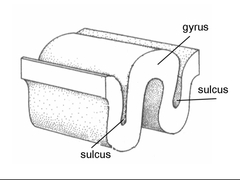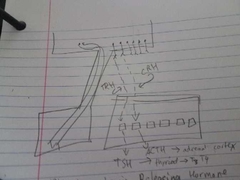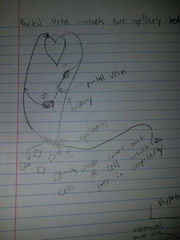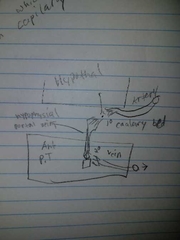![]()
![]()
![]()
Use LEFT and RIGHT arrow keys to navigate between flashcards;
Use UP and DOWN arrow keys to flip the card;
H to show hint;
A reads text to speech;
89 Cards in this Set
- Front
- Back
- 3rd side (hint)
|
Dermatomes |
Sensory regions of skin associated with specific neurons. -Diagnostics for spinal cord injuries. -Spinal Cords + spinal Nerve Plexus |
|
|
|
Plexus |
Braided network of different ventral rami of mixed n. |
|
|
|
Cervical Plexus |
•Made of C1-C5 •Phrenic N. •C3 C4 and C5 keep diaphram alive |
|
|
|
Phrenic N. |
a nerve that originates in the neck and passes down between the lung and heart to reach the diaphragm. It is important for breathing, as it passes motor information to the diaphragm and receives sensory information from it. |
|
|
|
Brachial Plexus (Has 5 Major Nerves) |
•C5-T1 •Upper extremity + shoulder |
|
|
|
Axillar Nerve (Brachail Plexus) |
Intervates deltoid |
|
|
|
Radial Nerve (Brachial Plexus) |
Deep in postier of arm - tricepts, wrists, and fingers. (Extenders) •Damage can lead to crutch paralysis (wrist droop or chicken wing) |
|
|
|
Musculocutaneous Nerve (Brachial Plexus) |
Anterior muscle of arm (forearm flexors) |
|
|
|
Ulnar Nerve (funny bone) (Brachial Plexus) |
•Along ulna •most intrinsic muscle of hand •Often damaged with prologued palm pressure |
|
|
|
Median Nerve (Brachial Plexus) |
•most flexon muscle of flexor muscle of wrist, hand, and fingers •Carpal tunnel |
|
|
|
Obturator Nerve (Lumbosacral Plexus) |
Hip adductors |
|
|
|
Femoral Nerve (Lumbosacral Plexus) |
Hip Flexors + knee extensors |
|
|
|
Pudendal Nerve (Lumbosacral Plexus) |
Floor of pelvic region |
|
|
|
Tibial Nerve (Lumbosacral Plexus) |
Intervates hamstrings + Plantar Flexors •combined with common fibular nerve |
|
|
|
Common Fibular Nerve (Lumbosacral Plexus) |
Combined with tibial nerve |
|
|
|
Sciatic Nerve (Lumbosacral Plexus) |
Pinch and get sciatica |
|
|
|
Classification of Reflexes |
•Neural - based on motor division •Somatic Reflexes •Autonomic Reflexes |
|
|
|
Integration Site for Reflexus |
•Spinal relexes (integration in cord) •Cranial reflexes •Visceral reflexes (lrg abdominal ganglion) |
|
|
|
Pavlov's Dogs |
Dog's mouth water when they hear bell. |
|
|
|
Interneuron |
A nueron that circles to connect a strech reflex like in the patella |
|
|
|
Cranial Nerves |
•Part of the PNS •Leave the brain stem (from rostal->caudal) •I-XII •All originate in the cranium •Pass through boney opening in skull •Some are sensory only |
|
|
|
Olfactory I |
Sensory only |
|
|
|
Optic Nerve II |
Sensory only |
|
|
|
Oculomotor Nerve III |
•Motor only •Somatic fiber to extrinsic muscle of eye •Parasympathetic fibers to circular muscle fibers of the iris (contrictors) |
|
|
|
Trigeminal Nerve V |
•Largest •Mixed Nerve •Sensory for all of face and teeth •Somatic motor to all muscles of mastication (chewing) |
|
|
|
Facial Nerve VII |
•Mixed Nerve •Sensory for taste •Somatic Motor to all muscle of facial expression •Linked with Bell's Pasley |
|
|
|
Vistibulocochlear Nerve VIII |
•Sensory only •Balance and equilibrium •Hearing |
|
|
|
Vagus Nerve X |
•Mixed •Sensory and motor from abdominal + thoracic visera •Parasympathetic motor to visera •Pathways to heart + brouchiolar •Smooth Muscle |
|
|
|
Vasovagal Response |
•Both sensory and motor in same N.T •cross talk confusion Eg. Nuerocardiogenic Syncope |
|
|
|
Brain + CNS |
•Motor Cortex (Frontal Lobe) •Somatosensory cortex (Patial Lobe) •Both are central sulcus |
|
|
|
Broca's area (Left hemisphere) (Frontal Lobe) |
-word and speech production |
|
|
|
Prefrontal Cortex (Frontal Lobe) |
•CEO of appropriate behavior + decision making •last part of brain to complete development (takes longer for men) |
|
|
|
Occipital Lobe |
1° visual cortex 1° = primary |
|
|
|
Gyrus & Sulcus |

|
|
|
|
Temporal Lobe |
•Memory of words and Sounds •Auditory sensation |
|
|
|
Midbrain On Brain Stem |
•Hard wired for basic life support •Visual reflex center •Pain suppressor •Startle reflex •Part of RAS (Reticular Activating System) - keeps cortex alert and awake and also filter out sensory noise (backround noise) |
|
|
|
Pons on Brain Stem |
•Bridge area for fiber tracks between cerebellum and cortex •Works with medulla to regulate breathing |
|
|
|
Medulla Oblongata of Brain Stem (has nuclei) |
•Cardiovascular Center •Vascular center - regulates blood vessel dialation •vasoconstriction = increase blood pressure •vasodialation = decrease blood pressure •Cardiac center - adjusts HR for high or low •Respitory System •Works with Pons to corrdinste breathing •Emetic Center -vomiting, caughing, and sneezing -Pyramids = desending somatic motor tracks aka pyramid tracks |
|
|
|
Grey Matter |
•Center of vertebrae •Unmyelinated cell bodies and axon |
|
|
|
Basal Nuclei (ganglia) |
•control of rythmic movement •Affected by Parkinson's-less dopamine |
|
|
|
Limbic System "emotion brain" |
•Several structures •Damage cause Alzheimer's |
|
|
|
Amygdala (limbic structure) |
Links emotions and smell to memories and learning. - PTSD |
|
|
|
Hippocampus (Limbic Structures) |
Necessary for forming new memories. |
|
|
|
Diencephalon |
•Homeostasis |
|
|
|
Thalamus (Diencephalon) |
•Sensory relay station •Memory processing and learning |
|
|
|
Hypothalamus (Diencephalon) |
•Integration site for sensory + autonomic + endocrine system •Several nuclei - body temp, thirst, and hunger centers •Rhythms (wake sleep) and sex drive •Hormonal regulation of pituitary gland |
|
|
|
Cerebellum |
•Movement coordination •"talks" with motor cortex •Recieves somatosensory and propiation inputs •involved in motor learning •involved in learning |
|
|
|
Dura Mater (tough) |
•Forms dural sinuses to drain venous-blood from brain •Epidural space in vert. Col. Fat filled |
|
|
|
Arachniod (like spider webs) |
•subarachnoid space has blood vessels + C.S.F •Common site for hemorrhaging stroke |
|
|
|
Pia Mater |
Attached to surface of brain + spinal cord |
|
|
|
Meningitis (inflammation of meninges) |
•usually affects arachniod and subarachnoid space •inflammation = swelling = increased cranial press |
|
|
|
Bacterial vs Viral (Meningitis) |
Bacterial: very serious - antibiotics don't pass blood brain barrier. Viral: Eg. West mile virus |
|
|
|
Onset of Symptoms (Meningitis) |
Headache, fever, flu-like pain. |
|
|
|
Endocrine System = Neuroendocrine |
Uses cell signaling molecules (chemical messages) |
|
|
|
Autocrines (endocrine system) |
•Self regulating hormone •homone that leaves cell attaches to itself |
|
|
|
Paracrines (endocrine system) |
Target or regulate neighbor cells |
|
|
|
Endocrines (endocrine sytem) |
Regulate distant cells - through blood |
|
|
|
Intracellular Receptor |
Receptor in the cell. Yes, cells have receptors in the cell. |
|
|
|
Increased hormone increases target cell/tissue response |
If decrease hormone level, decreased target cell/tissue response |
|
|
|
Hormone Receptor Levels |
•Upregulation of receptors. Increased receptors •Down regulation of receptors. Decreased receptors |
|
|
|
Classes or Hormones |
Peptides, steroids, and biogenic amines |
|
|
|
Peptides/Small Proteins |
•Small and water soluble=extracellular receptors •Synthesized in advance and stored in secretory vesicles for exocytosis for later •Most common Eg all homones from hypothalmic and pituitary gland |
|
|
|
Steroids |
•All sythesized from cholesteral •Lipid soluble |
|
|
|
Biogenic Amines - amino acid derived |
•Catcholamine - NE, E, Dopamine •Thyroid Hormones - T4 = thyroxine T3 = Triodothyrobine |
|
|
|
Steroid Hormone Mechanism Of Action |
•Steroid Hormones - lipid soluble •Receptor in cell •Steroid binds with receptor->moves to nucleus •Steroid and recptor binds DNA, thus, affects gene expression = making new proteins |
|
|
|
Insulin |
•Produced by beta cells in pancreatic islets •Target=Most body cells •Response=Target cell absorbs/transports glucose inside •Exercise helps glucose regulation |
|
|
|
Glucagon |
•Produced by alpha cells in panceatic islets •Target=Liver •Response=Breakdown of glycogen into glucose to blood |
|
|
|
Hypophysis |
•Pituitary Gland |
|
|
|
Anterior Pituitary |
Adenohyphysis |
|
|
|
Post Pituitary |
Neurohypophysis |
|
|
|
Tropin |
•Tropic Hormone •hormone that targets/stimulates another endocrine tissue |
|
|
|
Hypothalamic - Hypophyseal Axis |
•Connection of control over pituitary gland |
|
|
|
ADH |
•Antidiuretic Hormone •Target=Kidney •Response=Less urine, more water retention |
|
|
|
OT |
•Oxytocin •Target=Uterus •Response=Increase force of contraction •Target=Mammary Gland •Respnse=Let's milk down |
|
|
|
Infundibulum |
Any of various funnel-shaped bodily passages |
|
|
|
TRH |
•Thyrotropin Releasing Hormone •Let's down TSH |
|
|
|
TSH |
•Thyroid Stimulating Hormone •Tropin •Target=Thyroid •Response=Release of thyroid hormones T3 & T4 |
|
|
|
T3 & T4 |
•Targets mostly body cells •Regulation of metabolism necessary for growth and development. |
|
|
|
CRH |
•Goes in Anterior Pituitary •Cortico Releasing Hormone •Releases ACTH |
|
|
|
ACTH |
•Adreno Cortico Tropic Hormone •Target=Adrenal Cortex •Response=Increase release of cortisol |

|
|
|
FSH |
•Follicle stimulating hormone •Target=glands (overies and testies) |
|
|
|
LH |
•Luteinizing hormone •Target=Gonads •Response= gametogenesis and produce + release sex hormones |
|
|
|
Portal Vein |
Connects two capillary beds |

|
|
|
Know This |

|
|
|
|
Know This Too |

|
|
|
|
Glucocorticoids (Steroid) |
•All affect glucose metabolism •Target=Many body cells •Signal for release of = ACTH |
|
|
|
Mineralocorticiods (steroid) |
•Eg, Aldosterone •Target=Kidneys •Response=Na and K balance •If increase of adosterone then increased Na retention which also means higher h2o •Signal is NOT ACTH |
|
|
|
Gonadocorticios (steroid) |
•Sex hormones |
|
|
|
Prednisone and Cortisol suppresses Immune System |
True |
|

